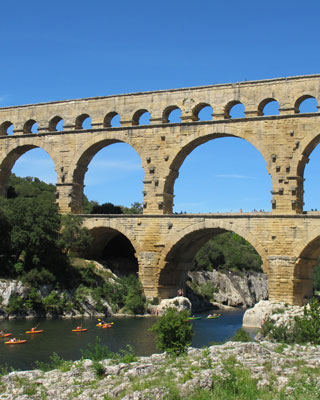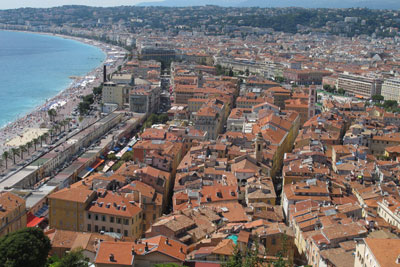Return to the Rhône
This item appears on page 48 of the January 2015 issue.
When I finished my junior year at Dartmouth College in 1961, my classmates and I suddenly realized that the upcoming summer would be our last long, free vacation time for many years. Once we graduated the following year, the carefree summer months would be replaced by graduate school, first jobs or military service.
My Dartmouth roommate, Charles, another classmate Bernie, Doug from my class at Deerfield Academy and I all decided to visit Europe. The four of us met in Paris, where we went to the Simca factory and leased a new Chrysler sedan, red and white with tailfins — quite flashy.
Our driving tour would continue through Italy, Austria, Romania, Poland, the Soviet Union and Scandinavia, then back to Paris, but we first spent several days in Paris seeing the sights, staying in pensions (the term “bed-and-breakfast” hadn’t been invented yet) and eating at bistros to get a feel for life in France. We enjoyed the experience of being footloose and fancy-free.
Fifty-two years later, I was planning my second trip to France, this time with my wife, Margi, who had spent a summer in Caen, Normandy and Grenoble in 1960. We decided it would be fun to explore an area that I had seen only briefly.
We booked a 13-day Rhône River cruise-tour, “Cruising Burgundy & Provence to the Côte d’Azur,” with Grand Circle Cruise Line (Boston, MA; 800/221-2610, www.gct.com). Our trip cost us a total of $10,018, which included airfare (Boston-Paris and Nice-Paris-Boston), hotels, the ship, a majority of the meals, ground transport and most entry fees.
Margi and I boarded an Air France flight from Boston to Paris on Aug. 5, 2013. The flight wasn’t quite as elegant as in the old days, but, even in economy class, the food was a cut above the usual fare.
We were met by a tour company rep and whisked into Paris on an expressway, something that barely existed in 1961.
Our hotel, the Novotel Paris Eiffel Tower, was located on the Seine and just a few blocks from the tower. We met Raphaele Charre, our tour director for the duration of the trip. She was articulate, vivacious, caring and fun.
Our group of 40 spent the first two days in Paris, where we had our only rain. We had free time to explore areas such as Montmartre.
Part of a day was spent in Giverny, where we were quite struck by the water garden Monet had created. His country home was comfortable but not ostentatious, and the village was charming.
Paris, of course, had retained its charm, although there was a lot more traffic than in ’61. The street scene was remarkably changed. I remember mostly the European French. Now the diversity was as striking as in America — lots of persons of color from, I expect, the former French colonies in Southeast Asia, North Africa and East Africa.
And, of course, no francs any more. The euro rules! Prices were fairly high. I would say that a meal, a stamp, a postcard or a book cost about 50% more than the similar item in the US, at least at the exchange rate at the time, €1=$1.40 (currently, €1=$1.24, so 24% more).
After several days, our group traveled by bus to the Saône River, which joins the Rhône. On the way to Macôn, where we would board the riverboat, we stopped at Beaune, a lovely small town noted for the Hôtel-Dieu de Beaune hospice, built in the 15th century as a charity hospital. The architecturally distinctive building is now a museum and shows the kitchen, dining room and wards.
Grand Circle’s 46-passenger Chardonnay is an older, refurbished ship. The upper deck, dining room, bar lounge, forward sunroom and even the cabins were most commodious. The top deck had two large awnings under which one could sit as the sun got hotter and watch the view or read, write or whatever. Our cabin had a sitting area, twin beds, a room for the toilet and sink, and a separate room for the sink and shower.
The ship’s officers were French, with the rest of the staff from Eastern Europe. Most spoke English and were congenial; they actually mingled with the passengers and were fun to be with.
The food was uniformly excellent. The kitchen crew often shopped for fresh bread and produce at local markets along the river.
That afternoon, we left the ship for an excursion into the Beaujolais region, including the lovely village of Pierres Dorées, built of golden stone, where we had extensive views of the lush, green, hilly countryside.
At Domaine des Averlys, we were introduced to the life of a vintner. The husband and wife running this vineyard were most hospitable. In the wine cellar, we tasted four wines along with cheese and sausage.
We entered Lyon after dusk, which at that time of year was around 9:30. Before leaving the city the next day, we had an interesting visit from and discussion with two members of the French Resistance, one of whom was 95.
In Tournon and Viviers, we met interesting families and dined on a terrace next to a pond and garden at one of the homes.
During a free afternoon at Avignon, Margi and I took a taxi to the Pont du Gard. It was one of the highest aqueducts built during the Roman Empire so was well known, but when I saw it in 1961 it had no tourist facilities of any kind. Not so now!
From a huge parking lot on one side of the Gardon River, visitors can walk up a road that allows access to the Pont du Gard’s mid-level “public” crossing. On the other side the road runs along the river, permitting ground-level views of each side of the 160-foot-high, 900-foot-long aqueduct. There are restaurants, a museum, a historical film, etc. We should have given ourselves more time.
By the next morning we had docked in Arles, which hadn’t changed much in 50 years. It was still a lovely, small city on the river with great views. The Roman amphitheater and Theatre Antique were quite well preserved and impressive.
Throughout the city were markers with photographs of van Gogh paintings that had been inspired by those locations. The famous scene in “Night Café,” for example, was recognizable, as was the scene in “Starry Night.”
In Carmargue, our group visited a wildlife area with farms that raised bulls for bullfighting. There are no kills at these fights in France, however. Instead, the objective is to remove a ribbon from the bull’s horns… without getting gored.
The next morning, passengers disembarked ship and Margi and I drove to Nice, a fascinating city deserving of more time than we had. We were glad to see that it didn’t have much high-rise architecture. Its great crescent of a beach curves along the shore for miles, and, although pebbly, it was packed with people that hot day. Behind Nice were fairly tall hills leading toward the Alps.
A river trip is certainly a relaxed method of travel, requiring no packing or unpacking. And this cruise with GCCL was a nice way to revisit a place and to see it has both changed and not changed.
DUSTY MILLER
Worcester, MA


